- What is nuclear medicine?
- What are radioactive tracers?
- What is Single Photon Emission Computed Tomography (SPECT)?
- What is Positron Emission Tomography (PET)?
- What are nuclear medicine scans used for?
- Are there risks?
- How are NIBIB-funded researchers advancing nuclear medicine?
What is nuclear medicine?
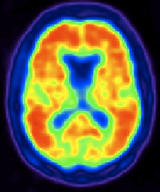
Nuclear medicine is a medical specialty that uses radioactive tracers (radiopharmaceuticals) to assess bodily functions and to diagnose and treat disease. Specially designed cameras allow doctors to track the path of these radioactive tracers. Single Photon Emission Computed Tomography or SPECT and Positron Emission Tomography or PET scans are the two most common imaging modalities in nuclear medicine.
What are radioactive tracers?
Radioactive tracers are made up of carrier molecules that are bonded tightly to a radioactive atom. These carrier molecules vary greatly depending on the purpose of the scan. Some tracers employ molecules that interact with a specific protein or sugar in the body and can even employ the patient’s own cells. For example, in cases where doctors need to know the exact source of intestinal bleeding, they may radiolabel (add radioactive atoms) to a sample of red blood cells taken from the patient. They then reinject the blood and use a SPECT scan to follow the path of the blood in the patient. Any accumulation of radioactivity in the intestines informs doctors of where the problem lies.
For most diagnostic studies in nuclear medicine, the radioactive tracer is administered to a patient by intravenous injection. However a radioactive tracer may also be administered by inhalation, by oral ingestion, or by direct injection into an organ. The mode of tracer administration will depend on the disease process that is to be studied.
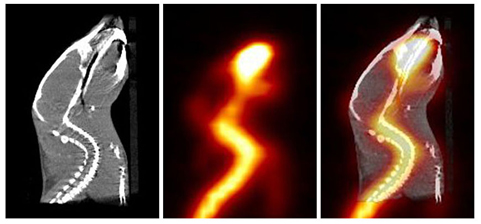
Approved tracers are called radiopharmaceuticals since they must meet FDA’s exacting standards for safety and appropriate performance for the approved clinical use. The nuclear medicine physician will select the tracer that will provide the most specific and reliable information for a patient’s particular problem. The tracer that is used determines whether the patient receives a SPECT or PET scan.
What is Single Photon Emission Computed Tomography (SPECT)?
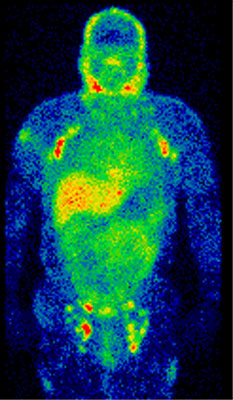
SPECT imaging instruments provide three-dimensional (tomographic) images of the distribution of radioactive tracer molecules that have been introduced into the patient’s body. The 3D images are computer generated from a large number of projection images of the body recorded at different angles. SPECT imagers have gamma camera detectors that can detect the gamma ray emissions from the tracers that have been injected into the patient. Gamma rays are a form of light that moves at a different wavelength than visible light. The cameras are mounted on a rotating gantry that allows the detectors to be moved in a tight circle around a patient who is lying motionless on a pallet.
What is Positron Emission Tomography (PET)?
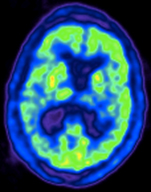 PET scans also use radiopharmaceuticals to create three-dimensional images. The main difference between SPECT and PET scans is the type of radiotracers used. While SPECT scans measure gamma rays, the decay of the radiotracers used with PET scans produce small particles called positrons. A positron is a particle with roughly the same mass as an electron but oppositely charged. These react with electrons in the body and when these two particles combine they annihilate each other. This annihilation produces a small amount of energy in the form of two photons that shoot off in opposite directions. The detectors in the PET scanner measure these photons and use this information to create images of internal organs.
PET scans also use radiopharmaceuticals to create three-dimensional images. The main difference between SPECT and PET scans is the type of radiotracers used. While SPECT scans measure gamma rays, the decay of the radiotracers used with PET scans produce small particles called positrons. A positron is a particle with roughly the same mass as an electron but oppositely charged. These react with electrons in the body and when these two particles combine they annihilate each other. This annihilation produces a small amount of energy in the form of two photons that shoot off in opposite directions. The detectors in the PET scanner measure these photons and use this information to create images of internal organs.
What are nuclear medicine scans used for?
SPECT scans are primarily used to diagnose and track the progression of heart disease, such as blocked coronary arteries. There are also radiotracers to detect disorders in bone, gall bladder disease and intestinal bleeding. SPECT agents have recently become available for aiding in the diagnosis of Parkinson's disease in the brain, and distinguishing this malady from other anatomically-related movement disorders and dementias.
The major purpose of PET scans is to detect cancer and monitor its progression, response to treatment, and to detect metastases. Glucose utilization depends on the intensity of cellular and tissue activity so it is greatly increased in rapidly dividing cancer cells. In fact, the degree of aggressiveness for most cancers is roughly paralleled by their rate of glucose utilization. In the last 15 years, slightly modified radiolabeled glucose molecules (F-18 labeled deoxyglucose or FDG) have been shown to be the best available tracer for detecting cancer and its metastatic spread in the body.
A combination instrument that produces both PET and CT scans of the same body regions in one examination (PET/CT scanner) has become the primary imaging tool for the staging of most cancers worldwide.
Recently, a PET probe was approved by the FDA to aid in the accurate diagnosis of Alzheimer's disease, which previously could be diagnosed with accuracy only after a patient's death. In the absence of this PET imaging test, Alzheimer's disease can be difficult to distinguish from vascular dementia or other forms of dementia that affect older people.
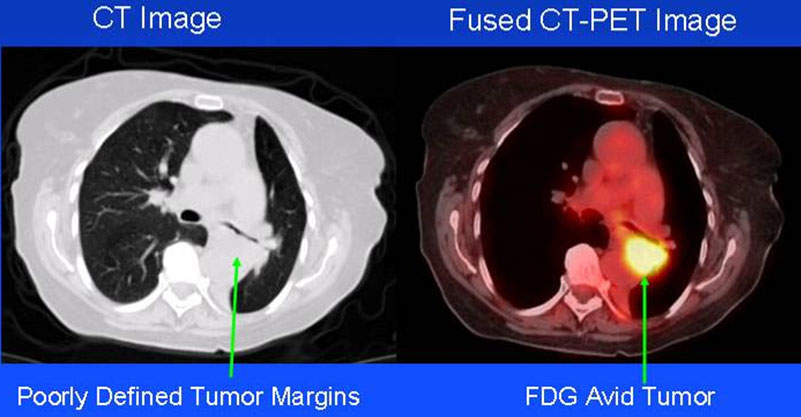
Are there risks?
The total radiation dose conferred to patients by the majority of radiopharmaceuticals used in diagnostic nuclear medicine studies is no more than what is conferred during routine chest x-rays or CT exams. There are legitimate concerns about possible cancer induction even by low levels of radiation exposure from cumulative medical imaging examinations, but this risk is accepted to be quite small in contrast to the expected benefit derived from a medically needed diagnostic imaging study.
Like radiologists, nuclear medicine physicians are strongly committed to keeping radiation exposure to patients as low as possible, giving the least amount of radiotracer needed to provide a diagnostically useful examination.
How are NIBIB-funded researchers advancing nuclear medicine?
Research in nuclear medicine involves developing new radio tracers as well as technologies that will help physicians produce clearer pictures.
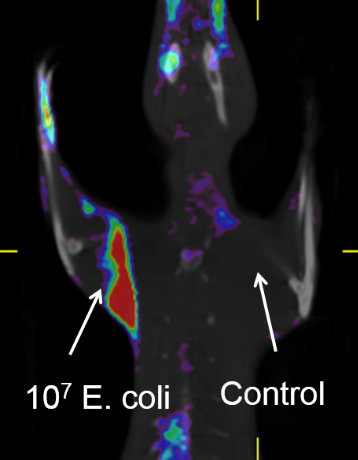
Developing new tracers
A bacterial infection is a common complication of implanting a medical device into the body. With more patients receiving device implants than ever before, infections from implants are a growing problem. Currently, these types of infections are diagnosed based on physical exam results and microbial cultures. However, such techniques are only useful for detecting late stage infections, which usually have already become difficult to treat. Conversely, medical devices may be needlessly removed when doctors mistake inflammation that is a normal consequence of surgery with inflammation due to an infection. NIBIB is currently supporting research to develop a new family of PET imaging contrast agents that are taken up specifically by bacterial cells, but not human cells. Such imaging agents would allow doctors to visualize early-stage bacterial infections so they can be easily treated, thereby reducing the number of implanted devices that are unnecessarily removed. They also have the potential to be used for diagnosing infections not associated with medical devices, for example, those affecting the heart or lungs.
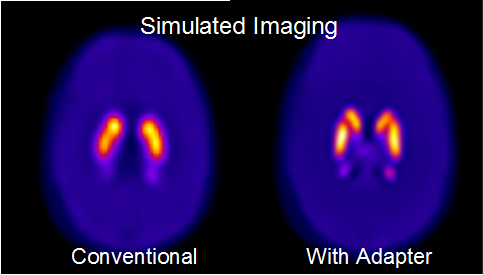
Creating new technology
A SPECT tracer is currently available for accurate diagnosis of Parkinson's disease. However, the small region in the brain that must be imaged requires a dedicated brain SPECT imager with special gamma cameras to provide high resolution, which adds to the cost of the procedure. NIBIB is supporting research to create an inexpensive adapter for the conventional SPECT imagers that most hospitals already have. The adapter would allow standard clinical SPECT cameras to provide the same high resolution that currently only dedicated SPECT brain imaging systems can produce. These improvements would make Parkinson’s diagnosis less costly and more widely available.
Reviewed July 2016
